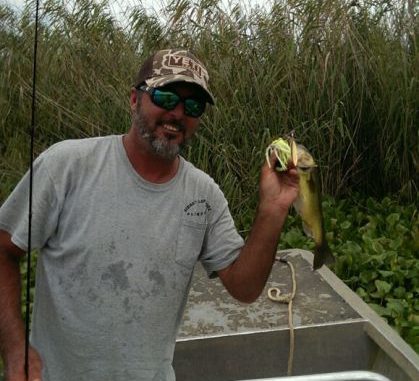
Work drop-offs along canal edges up against roseaus, angler says
With the Mississippi River just over 3 feet now in New Orleans, rapidly falling water has turned on the bass bite out of Venice.
“It was so high for so long, then all of a sudden the bottom fell out of it, and it happened quickly,” said longtime Venice fisherman Chip LeNormand. “Then the fish just turned on.”
And while the summer’s record-high river levels made the going rough for bass in the Delta National Wildlife Refuge, its retreat has made the whole area fishable now.
“Two months ago, that river was still up and there were only certain spots to fish. You really had to try to find the green, clean water, because it was so muddy,” he said. “But now, you can fish pretty much anywhere and catch bass because the river dropped and the water is clean everywhere now.”
LeNormand said bass action is fast and furious throughout Delta Duck and off Romere Pass, right along the roseaus with a watermelon and red flake Yum Christie Craw.
“The trick down there is you need a heavier bullet weight, like ⅜-ounce,” LeNormand said. “And you have to peg it with a toothpick so your weight doesn’t slide up and down.
“That way, when you get into those roseaus that are laying down, it can sink real quick and you don’t have anything blocking it.”
The key is to fish along cane with a good drop-off near the edge, not in areas with a flat sandbar extending from the roseaus, he said.
“Everything looks the same, but you have to find where it drops off 3 to 4 feet from the cane,” he said. “You have to find the water where it’s nice and pretty off the edge of the canes. Some canals are just pretty clear or black water, but you have to find the shelf.
“You need at least a 2- or 3-foot drop so when you flick it in there, it sinks real quick and they can come out of the canes and get it.”
Another key to success is timing the tides, he said.
“You have to catch the tides just right. You want to fish a falling tide, but you want to catch it before it gets too low, like an hour or two before it’s lowest,” LeNormand said. “You definitely want a low tide though, because they’ll stay in all those grass ponds that you can’t get to and in the roseasus, but when all that water comes out they have to get in the canals.
“They have no other choice.”
The bite is quick, usually on the initial fall, he said.
“If you keep jigging it and it feels like you have something, it’s probably going to be bream eating your crawdad up,” he said. “Right when you send it down, you’ll probably get a fish on. You’re not going to be jigging and jigging all the way back to the boat.
“The bite is mainly as soon as it goes down — that’s when you should have a fish.”
Spinnerbaits have also proven effective over grass and along the edges of the roseaus, he said. LeNormand has had success using a ⅜-ounce white-and-chartreuse H20 spinnerbait, with silver and gold willow blades.
“They’ve been on fire with the spinnerbaits throwing over the grass pads,” he said. “I’ve been catching 2-, 3- and 4-pounders with no problem.”
According to a fact sheet from the U.S. Fish and Wildlife Service, mud boats and air-cooled engines are not allowed, and fishing is prohibited during the state waterfowl season on Delta National Wildlife Refuge. However, it is permitted during teal season, youth waterfowl hunts and the Conservation Order for light geese.
For more information, click here.


